Financial Performance Management (FNN6800): Environmental Cost Report
VerifiedAdded on 2023/01/04
|12
|4077
|54
Report
AI Summary
This report, prepared for a Financial Performance Management module (FNN6800), critically examines the challenges businesses encounter in managing environmental costs. It delves into various environmental cost types, including compliance, preventive, and green costs, and analyzes the cost-benefit considerations involved. The report explores techniques for identifying and managing these costs, such as input/outflow analysis and activity-based costing, along with their importance in the context of increasing environmental awareness. The report also highlights how environmental costs are recorded and controlled through environmental management accounting (EMA) systems and planning tools like cash budgeting and zero-based budgeting. Part 2 of the report focuses on the importance of the decision-making process and the role of management accountants in providing the right information to improve business performance. It discusses the use of planning tools in solving financial problems. The report uses examples to illustrate key concepts and provides a comprehensive overview of the subject matter.
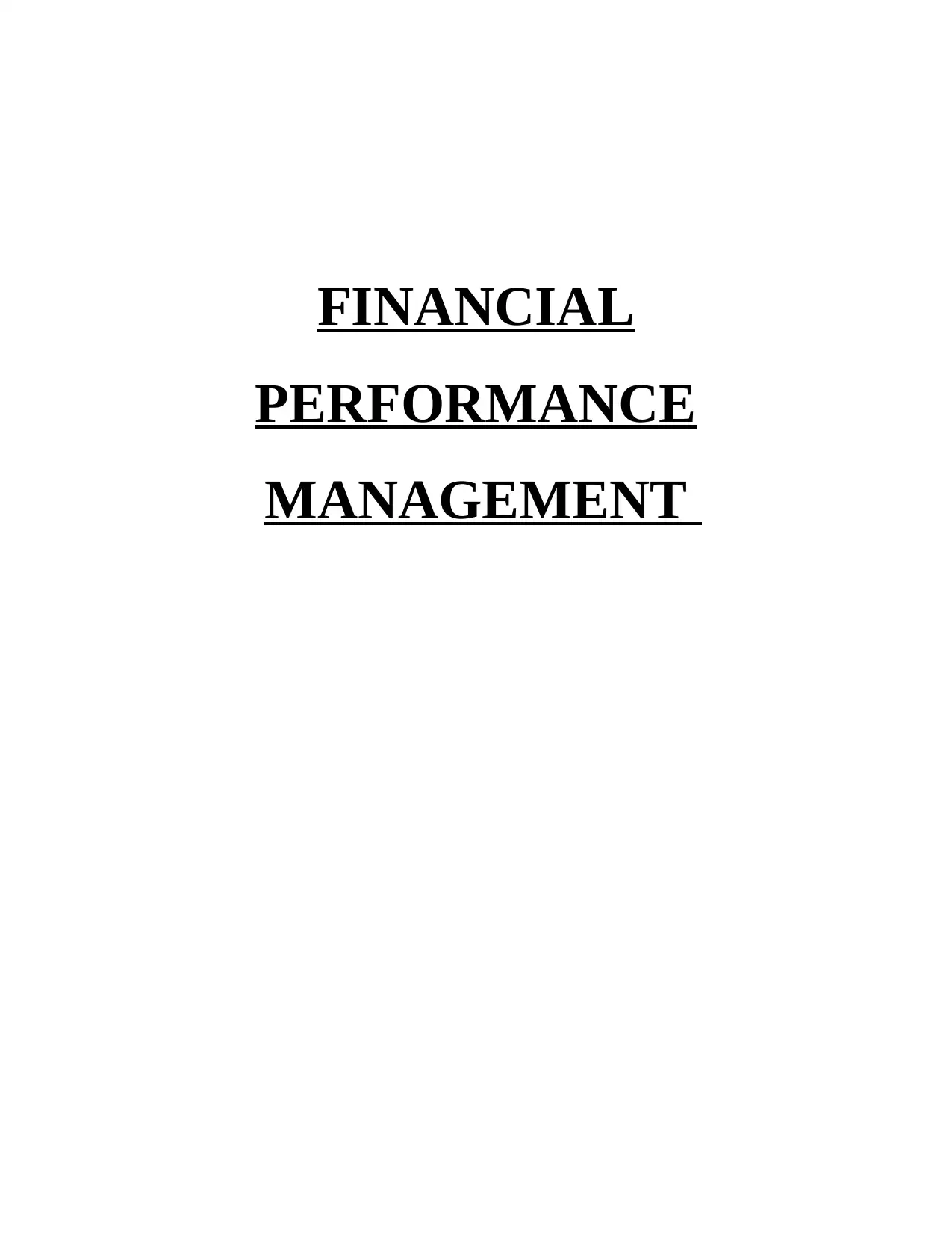
FINANCIAL
PERFORMANCE
MANAGEMENT
PERFORMANCE
MANAGEMENT
Paraphrase This Document
Need a fresh take? Get an instant paraphrase of this document with our AI Paraphraser
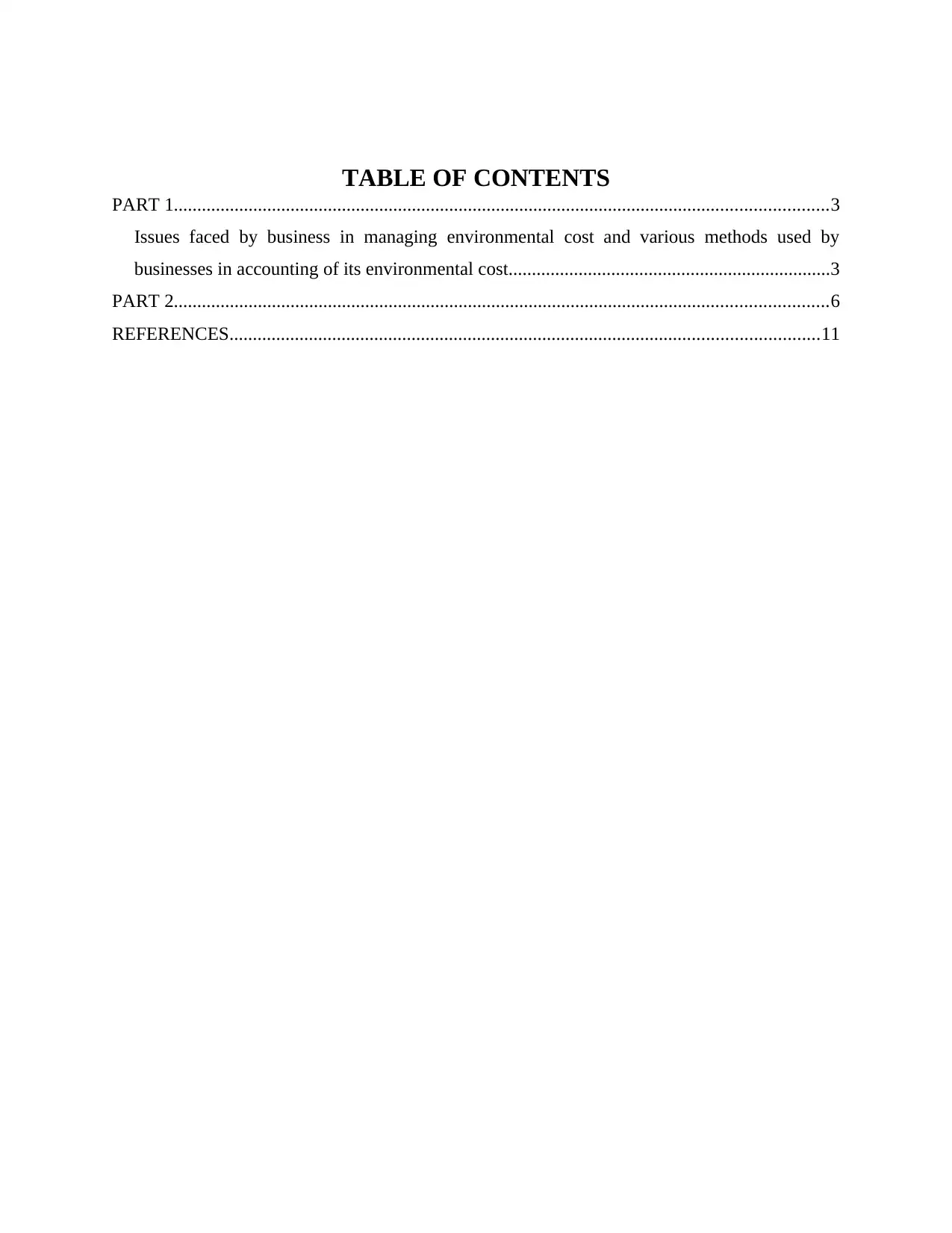
TABLE OF CONTENTS
PART 1............................................................................................................................................3
Issues faced by business in managing environmental cost and various methods used by
businesses in accounting of its environmental cost.....................................................................3
PART 2............................................................................................................................................6
REFERENCES..............................................................................................................................11
PART 1............................................................................................................................................3
Issues faced by business in managing environmental cost and various methods used by
businesses in accounting of its environmental cost.....................................................................3
PART 2............................................................................................................................................6
REFERENCES..............................................................................................................................11
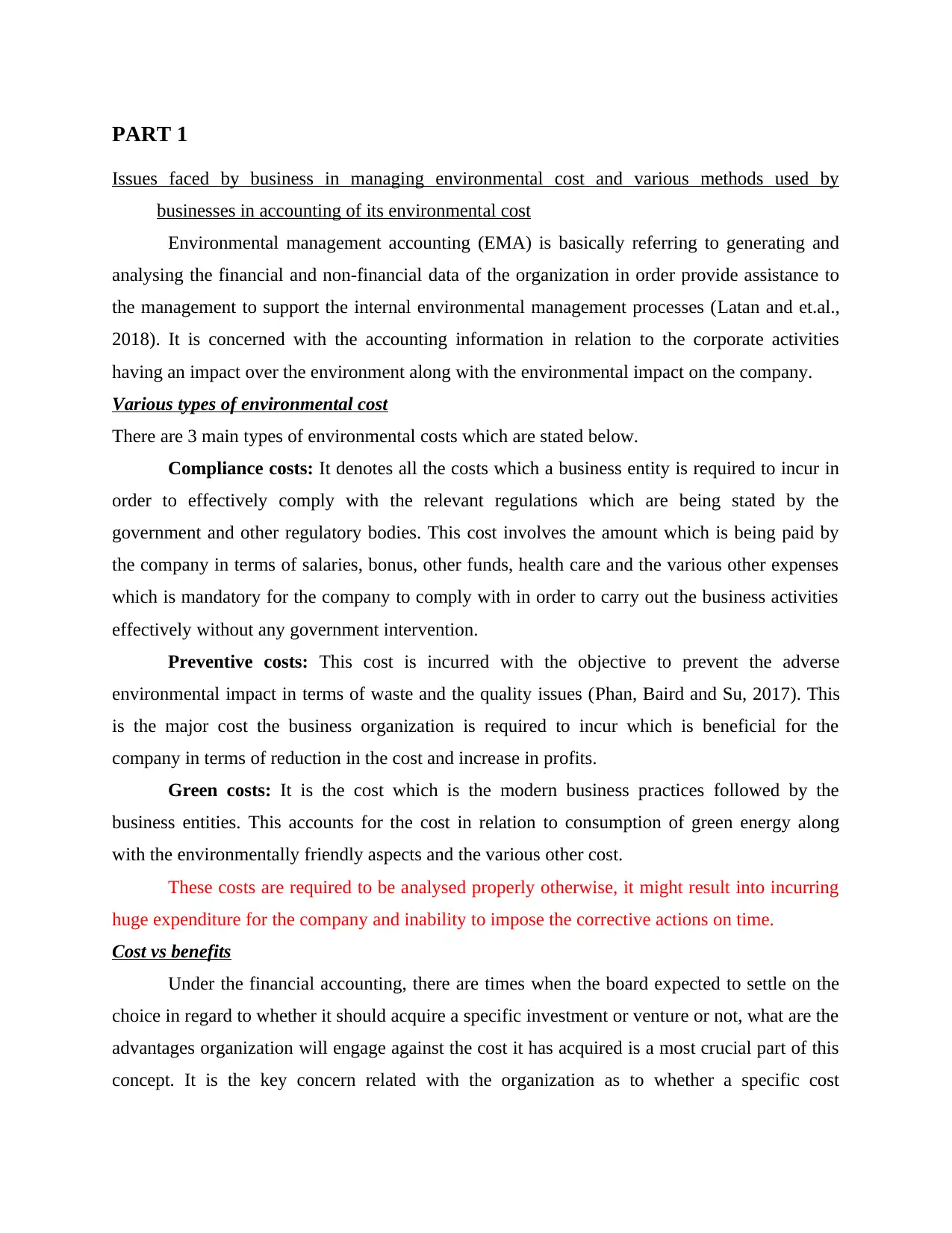
PART 1
Issues faced by business in managing environmental cost and various methods used by
businesses in accounting of its environmental cost
Environmental management accounting (EMA) is basically referring to generating and
analysing the financial and non-financial data of the organization in order provide assistance to
the management to support the internal environmental management processes (Latan and et.al.,
2018). It is concerned with the accounting information in relation to the corporate activities
having an impact over the environment along with the environmental impact on the company.
Various types of environmental cost
There are 3 main types of environmental costs which are stated below.
Compliance costs: It denotes all the costs which a business entity is required to incur in
order to effectively comply with the relevant regulations which are being stated by the
government and other regulatory bodies. This cost involves the amount which is being paid by
the company in terms of salaries, bonus, other funds, health care and the various other expenses
which is mandatory for the company to comply with in order to carry out the business activities
effectively without any government intervention.
Preventive costs: This cost is incurred with the objective to prevent the adverse
environmental impact in terms of waste and the quality issues (Phan, Baird and Su, 2017). This
is the major cost the business organization is required to incur which is beneficial for the
company in terms of reduction in the cost and increase in profits.
Green costs: It is the cost which is the modern business practices followed by the
business entities. This accounts for the cost in relation to consumption of green energy along
with the environmentally friendly aspects and the various other cost.
These costs are required to be analysed properly otherwise, it might result into incurring
huge expenditure for the company and inability to impose the corrective actions on time.
Cost vs benefits
Under the financial accounting, there are times when the board expected to settle on the
choice in regard to whether it should acquire a specific investment or venture or not, what are the
advantages organization will engage against the cost it has acquired is a most crucial part of this
concept. It is the key concern related with the organization as to whether a specific cost
Issues faced by business in managing environmental cost and various methods used by
businesses in accounting of its environmental cost
Environmental management accounting (EMA) is basically referring to generating and
analysing the financial and non-financial data of the organization in order provide assistance to
the management to support the internal environmental management processes (Latan and et.al.,
2018). It is concerned with the accounting information in relation to the corporate activities
having an impact over the environment along with the environmental impact on the company.
Various types of environmental cost
There are 3 main types of environmental costs which are stated below.
Compliance costs: It denotes all the costs which a business entity is required to incur in
order to effectively comply with the relevant regulations which are being stated by the
government and other regulatory bodies. This cost involves the amount which is being paid by
the company in terms of salaries, bonus, other funds, health care and the various other expenses
which is mandatory for the company to comply with in order to carry out the business activities
effectively without any government intervention.
Preventive costs: This cost is incurred with the objective to prevent the adverse
environmental impact in terms of waste and the quality issues (Phan, Baird and Su, 2017). This
is the major cost the business organization is required to incur which is beneficial for the
company in terms of reduction in the cost and increase in profits.
Green costs: It is the cost which is the modern business practices followed by the
business entities. This accounts for the cost in relation to consumption of green energy along
with the environmentally friendly aspects and the various other cost.
These costs are required to be analysed properly otherwise, it might result into incurring
huge expenditure for the company and inability to impose the corrective actions on time.
Cost vs benefits
Under the financial accounting, there are times when the board expected to settle on the
choice in regard to whether it should acquire a specific investment or venture or not, what are the
advantages organization will engage against the cost it has acquired is a most crucial part of this
concept. It is the key concern related with the organization as to whether a specific cost
⊘ This is a preview!⊘
Do you want full access?
Subscribe today to unlock all pages.

Trusted by 1+ million students worldwide
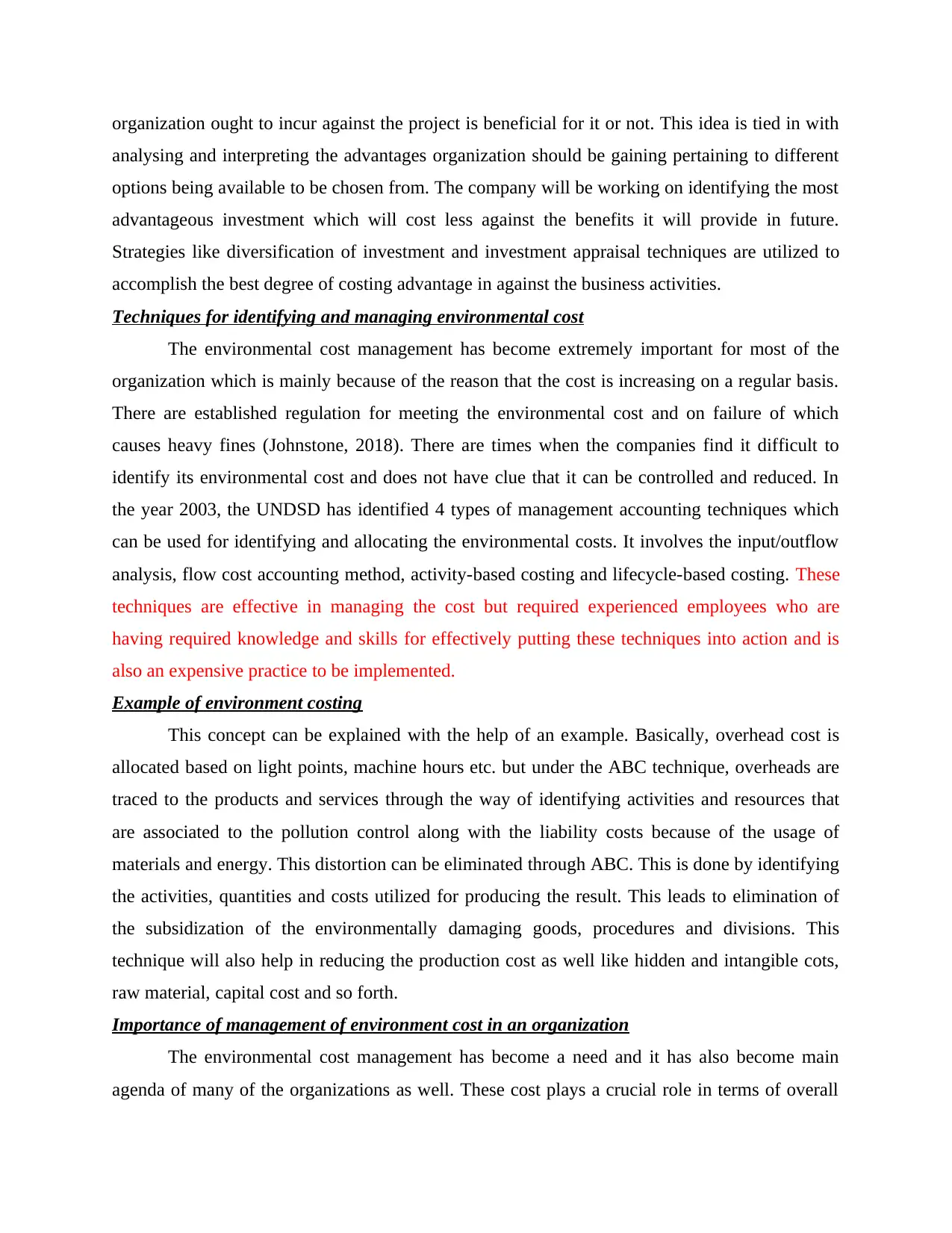
organization ought to incur against the project is beneficial for it or not. This idea is tied in with
analysing and interpreting the advantages organization should be gaining pertaining to different
options being available to be chosen from. The company will be working on identifying the most
advantageous investment which will cost less against the benefits it will provide in future.
Strategies like diversification of investment and investment appraisal techniques are utilized to
accomplish the best degree of costing advantage in against the business activities.
Techniques for identifying and managing environmental cost
The environmental cost management has become extremely important for most of the
organization which is mainly because of the reason that the cost is increasing on a regular basis.
There are established regulation for meeting the environmental cost and on failure of which
causes heavy fines (Johnstone, 2018). There are times when the companies find it difficult to
identify its environmental cost and does not have clue that it can be controlled and reduced. In
the year 2003, the UNDSD has identified 4 types of management accounting techniques which
can be used for identifying and allocating the environmental costs. It involves the input/outflow
analysis, flow cost accounting method, activity-based costing and lifecycle-based costing. These
techniques are effective in managing the cost but required experienced employees who are
having required knowledge and skills for effectively putting these techniques into action and is
also an expensive practice to be implemented.
Example of environment costing
This concept can be explained with the help of an example. Basically, overhead cost is
allocated based on light points, machine hours etc. but under the ABC technique, overheads are
traced to the products and services through the way of identifying activities and resources that
are associated to the pollution control along with the liability costs because of the usage of
materials and energy. This distortion can be eliminated through ABC. This is done by identifying
the activities, quantities and costs utilized for producing the result. This leads to elimination of
the subsidization of the environmentally damaging goods, procedures and divisions. This
technique will also help in reducing the production cost as well like hidden and intangible cots,
raw material, capital cost and so forth.
Importance of management of environment cost in an organization
The environmental cost management has become a need and it has also become main
agenda of many of the organizations as well. These cost plays a crucial role in terms of overall
analysing and interpreting the advantages organization should be gaining pertaining to different
options being available to be chosen from. The company will be working on identifying the most
advantageous investment which will cost less against the benefits it will provide in future.
Strategies like diversification of investment and investment appraisal techniques are utilized to
accomplish the best degree of costing advantage in against the business activities.
Techniques for identifying and managing environmental cost
The environmental cost management has become extremely important for most of the
organization which is mainly because of the reason that the cost is increasing on a regular basis.
There are established regulation for meeting the environmental cost and on failure of which
causes heavy fines (Johnstone, 2018). There are times when the companies find it difficult to
identify its environmental cost and does not have clue that it can be controlled and reduced. In
the year 2003, the UNDSD has identified 4 types of management accounting techniques which
can be used for identifying and allocating the environmental costs. It involves the input/outflow
analysis, flow cost accounting method, activity-based costing and lifecycle-based costing. These
techniques are effective in managing the cost but required experienced employees who are
having required knowledge and skills for effectively putting these techniques into action and is
also an expensive practice to be implemented.
Example of environment costing
This concept can be explained with the help of an example. Basically, overhead cost is
allocated based on light points, machine hours etc. but under the ABC technique, overheads are
traced to the products and services through the way of identifying activities and resources that
are associated to the pollution control along with the liability costs because of the usage of
materials and energy. This distortion can be eliminated through ABC. This is done by identifying
the activities, quantities and costs utilized for producing the result. This leads to elimination of
the subsidization of the environmentally damaging goods, procedures and divisions. This
technique will also help in reducing the production cost as well like hidden and intangible cots,
raw material, capital cost and so forth.
Importance of management of environment cost in an organization
The environmental cost management has become a need and it has also become main
agenda of many of the organizations as well. These cost plays a crucial role in terms of overall
Paraphrase This Document
Need a fresh take? Get an instant paraphrase of this document with our AI Paraphraser
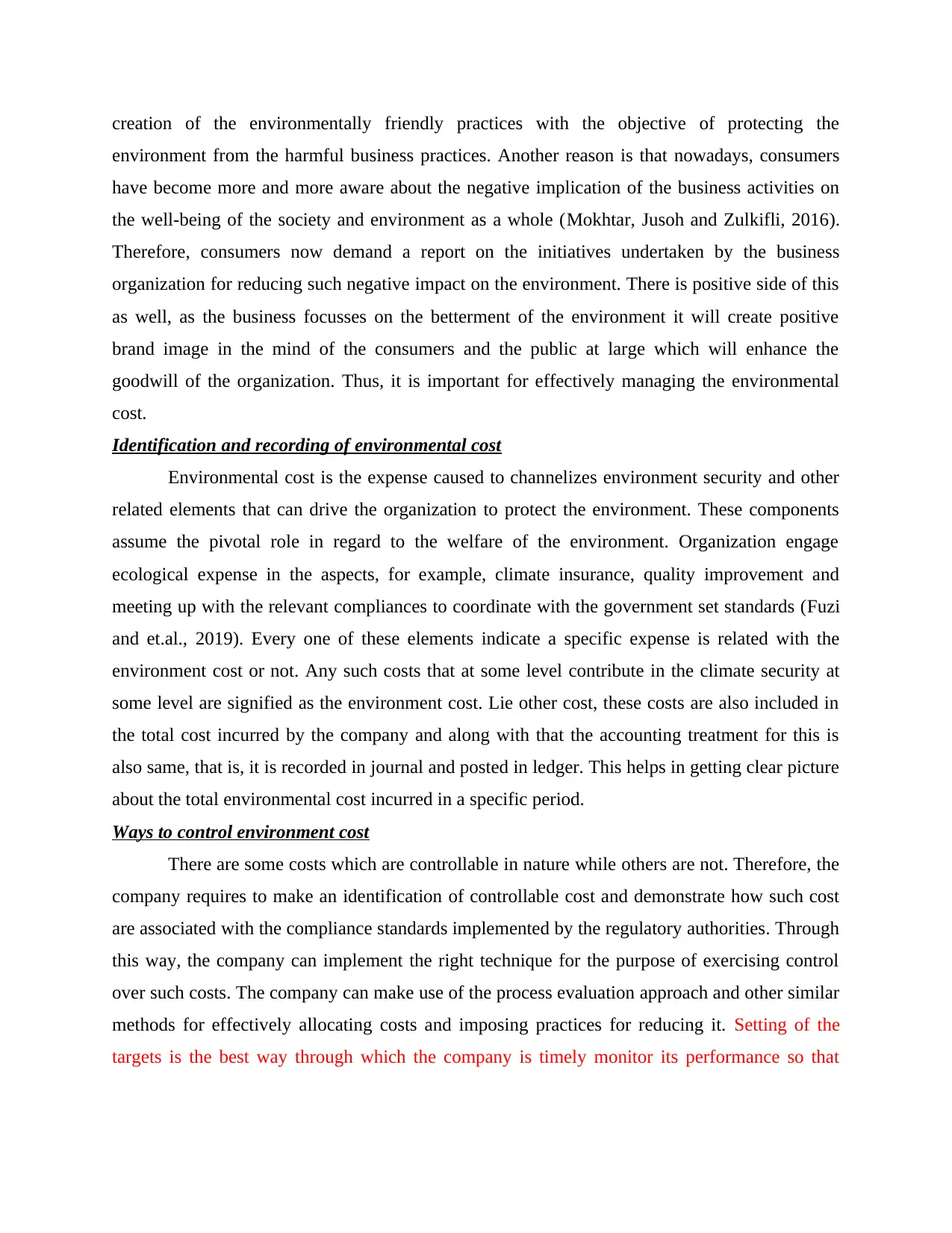
creation of the environmentally friendly practices with the objective of protecting the
environment from the harmful business practices. Another reason is that nowadays, consumers
have become more and more aware about the negative implication of the business activities on
the well-being of the society and environment as a whole (Mokhtar, Jusoh and Zulkifli, 2016).
Therefore, consumers now demand a report on the initiatives undertaken by the business
organization for reducing such negative impact on the environment. There is positive side of this
as well, as the business focusses on the betterment of the environment it will create positive
brand image in the mind of the consumers and the public at large which will enhance the
goodwill of the organization. Thus, it is important for effectively managing the environmental
cost.
Identification and recording of environmental cost
Environmental cost is the expense caused to channelizes environment security and other
related elements that can drive the organization to protect the environment. These components
assume the pivotal role in regard to the welfare of the environment. Organization engage
ecological expense in the aspects, for example, climate insurance, quality improvement and
meeting up with the relevant compliances to coordinate with the government set standards (Fuzi
and et.al., 2019). Every one of these elements indicate a specific expense is related with the
environment cost or not. Any such costs that at some level contribute in the climate security at
some level are signified as the environment cost. Lie other cost, these costs are also included in
the total cost incurred by the company and along with that the accounting treatment for this is
also same, that is, it is recorded in journal and posted in ledger. This helps in getting clear picture
about the total environmental cost incurred in a specific period.
Ways to control environment cost
There are some costs which are controllable in nature while others are not. Therefore, the
company requires to make an identification of controllable cost and demonstrate how such cost
are associated with the compliance standards implemented by the regulatory authorities. Through
this way, the company can implement the right technique for the purpose of exercising control
over such costs. The company can make use of the process evaluation approach and other similar
methods for effectively allocating costs and imposing practices for reducing it. Setting of the
targets is the best way through which the company is timely monitor its performance so that
environment from the harmful business practices. Another reason is that nowadays, consumers
have become more and more aware about the negative implication of the business activities on
the well-being of the society and environment as a whole (Mokhtar, Jusoh and Zulkifli, 2016).
Therefore, consumers now demand a report on the initiatives undertaken by the business
organization for reducing such negative impact on the environment. There is positive side of this
as well, as the business focusses on the betterment of the environment it will create positive
brand image in the mind of the consumers and the public at large which will enhance the
goodwill of the organization. Thus, it is important for effectively managing the environmental
cost.
Identification and recording of environmental cost
Environmental cost is the expense caused to channelizes environment security and other
related elements that can drive the organization to protect the environment. These components
assume the pivotal role in regard to the welfare of the environment. Organization engage
ecological expense in the aspects, for example, climate insurance, quality improvement and
meeting up with the relevant compliances to coordinate with the government set standards (Fuzi
and et.al., 2019). Every one of these elements indicate a specific expense is related with the
environment cost or not. Any such costs that at some level contribute in the climate security at
some level are signified as the environment cost. Lie other cost, these costs are also included in
the total cost incurred by the company and along with that the accounting treatment for this is
also same, that is, it is recorded in journal and posted in ledger. This helps in getting clear picture
about the total environmental cost incurred in a specific period.
Ways to control environment cost
There are some costs which are controllable in nature while others are not. Therefore, the
company requires to make an identification of controllable cost and demonstrate how such cost
are associated with the compliance standards implemented by the regulatory authorities. Through
this way, the company can implement the right technique for the purpose of exercising control
over such costs. The company can make use of the process evaluation approach and other similar
methods for effectively allocating costs and imposing practices for reducing it. Setting of the
targets is the best way through which the company is timely monitor its performance so that
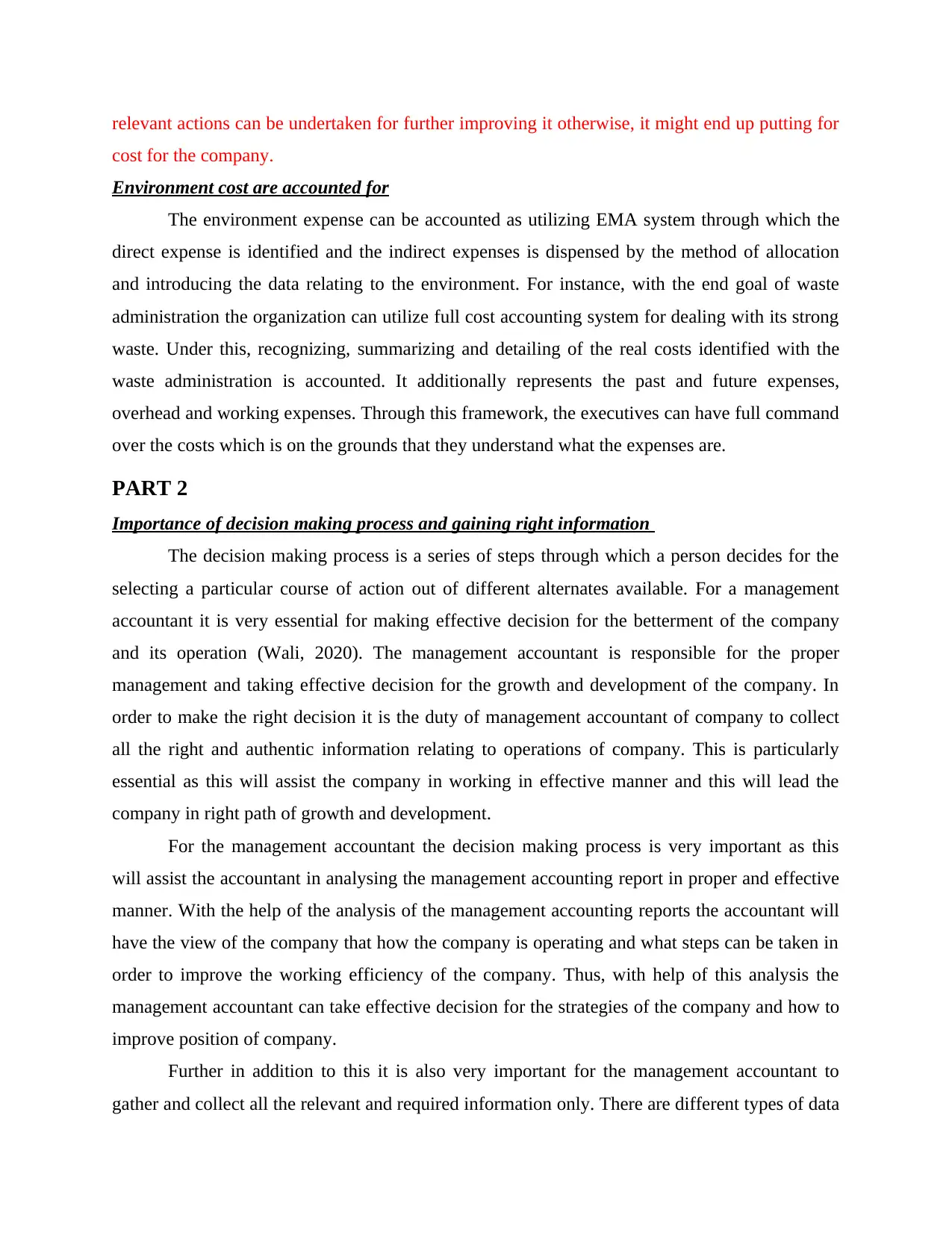
relevant actions can be undertaken for further improving it otherwise, it might end up putting for
cost for the company.
Environment cost are accounted for
The environment expense can be accounted as utilizing EMA system through which the
direct expense is identified and the indirect expenses is dispensed by the method of allocation
and introducing the data relating to the environment. For instance, with the end goal of waste
administration the organization can utilize full cost accounting system for dealing with its strong
waste. Under this, recognizing, summarizing and detailing of the real costs identified with the
waste administration is accounted. It additionally represents the past and future expenses,
overhead and working expenses. Through this framework, the executives can have full command
over the costs which is on the grounds that they understand what the expenses are.
PART 2
Importance of decision making process and gaining right information
The decision making process is a series of steps through which a person decides for the
selecting a particular course of action out of different alternates available. For a management
accountant it is very essential for making effective decision for the betterment of the company
and its operation (Wali, 2020). The management accountant is responsible for the proper
management and taking effective decision for the growth and development of the company. In
order to make the right decision it is the duty of management accountant of company to collect
all the right and authentic information relating to operations of company. This is particularly
essential as this will assist the company in working in effective manner and this will lead the
company in right path of growth and development.
For the management accountant the decision making process is very important as this
will assist the accountant in analysing the management accounting report in proper and effective
manner. With the help of the analysis of the management accounting reports the accountant will
have the view of the company that how the company is operating and what steps can be taken in
order to improve the working efficiency of the company. Thus, with help of this analysis the
management accountant can take effective decision for the strategies of the company and how to
improve position of company.
Further in addition to this it is also very important for the management accountant to
gather and collect all the relevant and required information only. There are different types of data
cost for the company.
Environment cost are accounted for
The environment expense can be accounted as utilizing EMA system through which the
direct expense is identified and the indirect expenses is dispensed by the method of allocation
and introducing the data relating to the environment. For instance, with the end goal of waste
administration the organization can utilize full cost accounting system for dealing with its strong
waste. Under this, recognizing, summarizing and detailing of the real costs identified with the
waste administration is accounted. It additionally represents the past and future expenses,
overhead and working expenses. Through this framework, the executives can have full command
over the costs which is on the grounds that they understand what the expenses are.
PART 2
Importance of decision making process and gaining right information
The decision making process is a series of steps through which a person decides for the
selecting a particular course of action out of different alternates available. For a management
accountant it is very essential for making effective decision for the betterment of the company
and its operation (Wali, 2020). The management accountant is responsible for the proper
management and taking effective decision for the growth and development of the company. In
order to make the right decision it is the duty of management accountant of company to collect
all the right and authentic information relating to operations of company. This is particularly
essential as this will assist the company in working in effective manner and this will lead the
company in right path of growth and development.
For the management accountant the decision making process is very important as this
will assist the accountant in analysing the management accounting report in proper and effective
manner. With the help of the analysis of the management accounting reports the accountant will
have the view of the company that how the company is operating and what steps can be taken in
order to improve the working efficiency of the company. Thus, with help of this analysis the
management accountant can take effective decision for the strategies of the company and how to
improve position of company.
Further in addition to this it is also very important for the management accountant to
gather and collect all the relevant and required information only. There are different types of data
⊘ This is a preview!⊘
Do you want full access?
Subscribe today to unlock all pages.

Trusted by 1+ million students worldwide
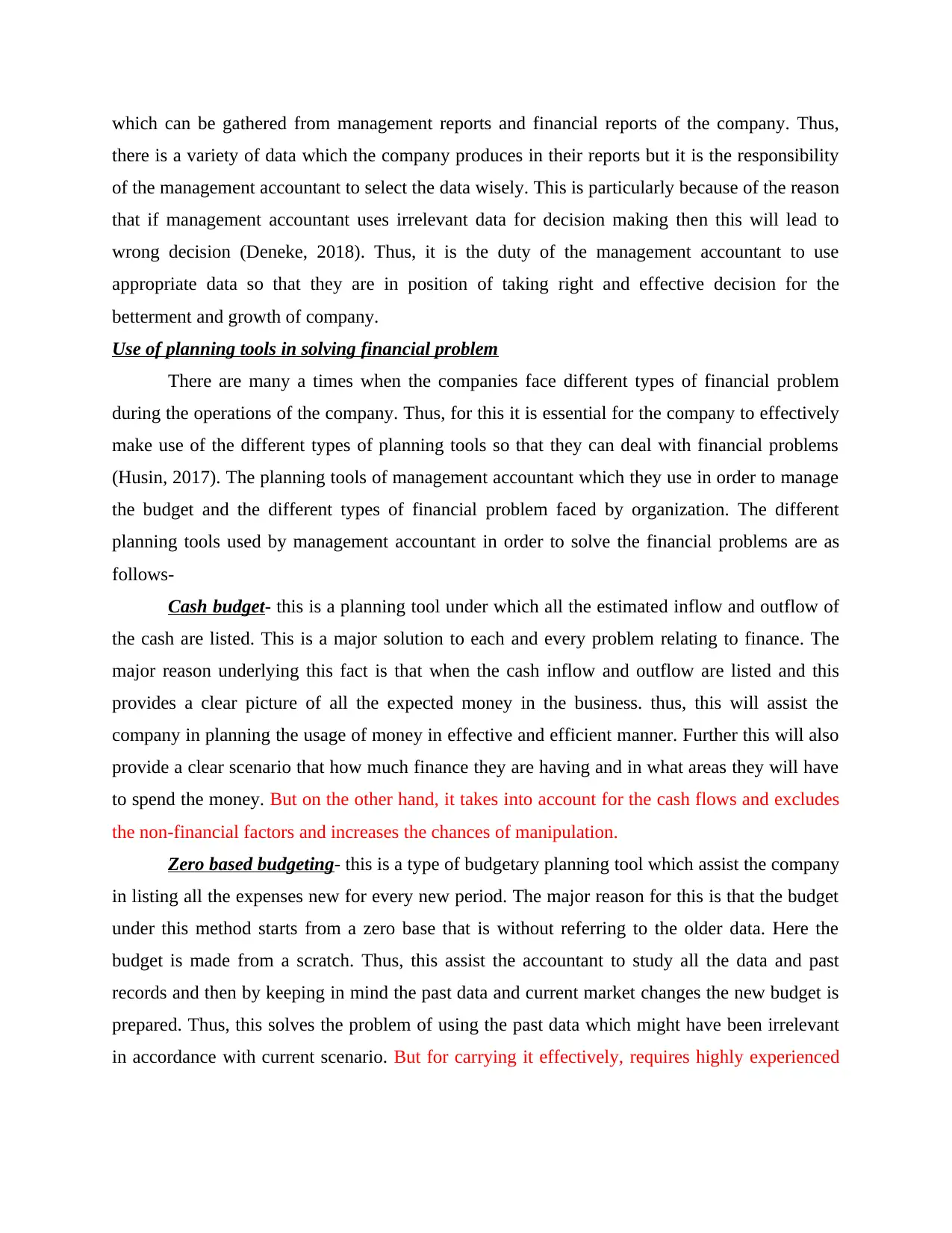
which can be gathered from management reports and financial reports of the company. Thus,
there is a variety of data which the company produces in their reports but it is the responsibility
of the management accountant to select the data wisely. This is particularly because of the reason
that if management accountant uses irrelevant data for decision making then this will lead to
wrong decision (Deneke, 2018). Thus, it is the duty of the management accountant to use
appropriate data so that they are in position of taking right and effective decision for the
betterment and growth of company.
Use of planning tools in solving financial problem
There are many a times when the companies face different types of financial problem
during the operations of the company. Thus, for this it is essential for the company to effectively
make use of the different types of planning tools so that they can deal with financial problems
(Husin, 2017). The planning tools of management accountant which they use in order to manage
the budget and the different types of financial problem faced by organization. The different
planning tools used by management accountant in order to solve the financial problems are as
follows-
Cash budget- this is a planning tool under which all the estimated inflow and outflow of
the cash are listed. This is a major solution to each and every problem relating to finance. The
major reason underlying this fact is that when the cash inflow and outflow are listed and this
provides a clear picture of all the expected money in the business. thus, this will assist the
company in planning the usage of money in effective and efficient manner. Further this will also
provide a clear scenario that how much finance they are having and in what areas they will have
to spend the money. But on the other hand, it takes into account for the cash flows and excludes
the non-financial factors and increases the chances of manipulation.
Zero based budgeting- this is a type of budgetary planning tool which assist the company
in listing all the expenses new for every new period. The major reason for this is that the budget
under this method starts from a zero base that is without referring to the older data. Here the
budget is made from a scratch. Thus, this assist the accountant to study all the data and past
records and then by keeping in mind the past data and current market changes the new budget is
prepared. Thus, this solves the problem of using the past data which might have been irrelevant
in accordance with current scenario. But for carrying it effectively, requires highly experienced
there is a variety of data which the company produces in their reports but it is the responsibility
of the management accountant to select the data wisely. This is particularly because of the reason
that if management accountant uses irrelevant data for decision making then this will lead to
wrong decision (Deneke, 2018). Thus, it is the duty of the management accountant to use
appropriate data so that they are in position of taking right and effective decision for the
betterment and growth of company.
Use of planning tools in solving financial problem
There are many a times when the companies face different types of financial problem
during the operations of the company. Thus, for this it is essential for the company to effectively
make use of the different types of planning tools so that they can deal with financial problems
(Husin, 2017). The planning tools of management accountant which they use in order to manage
the budget and the different types of financial problem faced by organization. The different
planning tools used by management accountant in order to solve the financial problems are as
follows-
Cash budget- this is a planning tool under which all the estimated inflow and outflow of
the cash are listed. This is a major solution to each and every problem relating to finance. The
major reason underlying this fact is that when the cash inflow and outflow are listed and this
provides a clear picture of all the expected money in the business. thus, this will assist the
company in planning the usage of money in effective and efficient manner. Further this will also
provide a clear scenario that how much finance they are having and in what areas they will have
to spend the money. But on the other hand, it takes into account for the cash flows and excludes
the non-financial factors and increases the chances of manipulation.
Zero based budgeting- this is a type of budgetary planning tool which assist the company
in listing all the expenses new for every new period. The major reason for this is that the budget
under this method starts from a zero base that is without referring to the older data. Here the
budget is made from a scratch. Thus, this assist the accountant to study all the data and past
records and then by keeping in mind the past data and current market changes the new budget is
prepared. Thus, this solves the problem of using the past data which might have been irrelevant
in accordance with current scenario. But for carrying it effectively, requires highly experienced
Paraphrase This Document
Need a fresh take? Get an instant paraphrase of this document with our AI Paraphraser
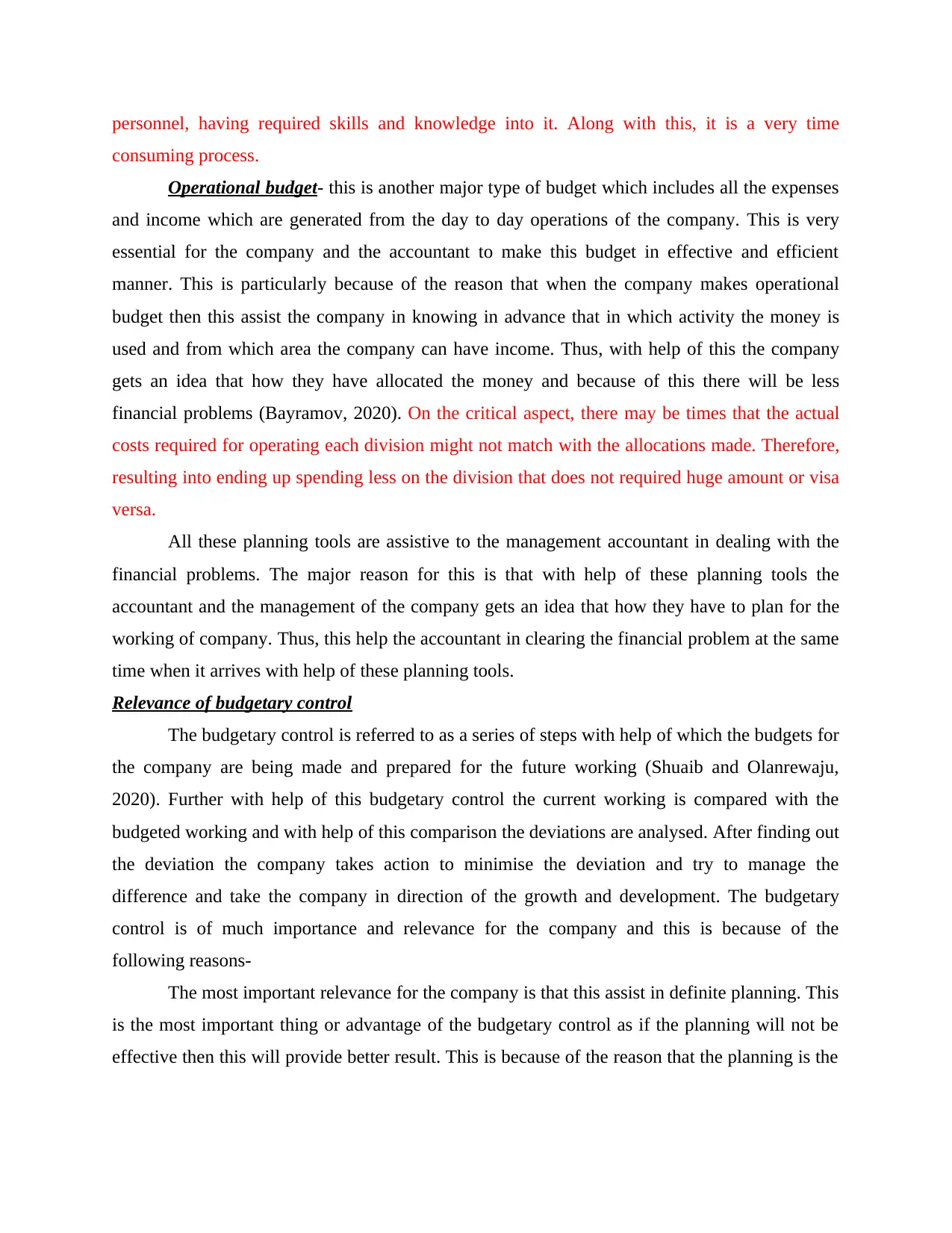
personnel, having required skills and knowledge into it. Along with this, it is a very time
consuming process.
Operational budget- this is another major type of budget which includes all the expenses
and income which are generated from the day to day operations of the company. This is very
essential for the company and the accountant to make this budget in effective and efficient
manner. This is particularly because of the reason that when the company makes operational
budget then this assist the company in knowing in advance that in which activity the money is
used and from which area the company can have income. Thus, with help of this the company
gets an idea that how they have allocated the money and because of this there will be less
financial problems (Bayramov, 2020). On the critical aspect, there may be times that the actual
costs required for operating each division might not match with the allocations made. Therefore,
resulting into ending up spending less on the division that does not required huge amount or visa
versa.
All these planning tools are assistive to the management accountant in dealing with the
financial problems. The major reason for this is that with help of these planning tools the
accountant and the management of the company gets an idea that how they have to plan for the
working of company. Thus, this help the accountant in clearing the financial problem at the same
time when it arrives with help of these planning tools.
Relevance of budgetary control
The budgetary control is referred to as a series of steps with help of which the budgets for
the company are being made and prepared for the future working (Shuaib and Olanrewaju,
2020). Further with help of this budgetary control the current working is compared with the
budgeted working and with help of this comparison the deviations are analysed. After finding out
the deviation the company takes action to minimise the deviation and try to manage the
difference and take the company in direction of the growth and development. The budgetary
control is of much importance and relevance for the company and this is because of the
following reasons-
The most important relevance for the company is that this assist in definite planning. This
is the most important thing or advantage of the budgetary control as if the planning will not be
effective then this will provide better result. This is because of the reason that the planning is the
consuming process.
Operational budget- this is another major type of budget which includes all the expenses
and income which are generated from the day to day operations of the company. This is very
essential for the company and the accountant to make this budget in effective and efficient
manner. This is particularly because of the reason that when the company makes operational
budget then this assist the company in knowing in advance that in which activity the money is
used and from which area the company can have income. Thus, with help of this the company
gets an idea that how they have allocated the money and because of this there will be less
financial problems (Bayramov, 2020). On the critical aspect, there may be times that the actual
costs required for operating each division might not match with the allocations made. Therefore,
resulting into ending up spending less on the division that does not required huge amount or visa
versa.
All these planning tools are assistive to the management accountant in dealing with the
financial problems. The major reason for this is that with help of these planning tools the
accountant and the management of the company gets an idea that how they have to plan for the
working of company. Thus, this help the accountant in clearing the financial problem at the same
time when it arrives with help of these planning tools.
Relevance of budgetary control
The budgetary control is referred to as a series of steps with help of which the budgets for
the company are being made and prepared for the future working (Shuaib and Olanrewaju,
2020). Further with help of this budgetary control the current working is compared with the
budgeted working and with help of this comparison the deviations are analysed. After finding out
the deviation the company takes action to minimise the deviation and try to manage the
difference and take the company in direction of the growth and development. The budgetary
control is of much importance and relevance for the company and this is because of the
following reasons-
The most important relevance for the company is that this assist in definite planning. This
is the most important thing or advantage of the budgetary control as if the planning will not be
effective then this will provide better result. This is because of the reason that the planning is the
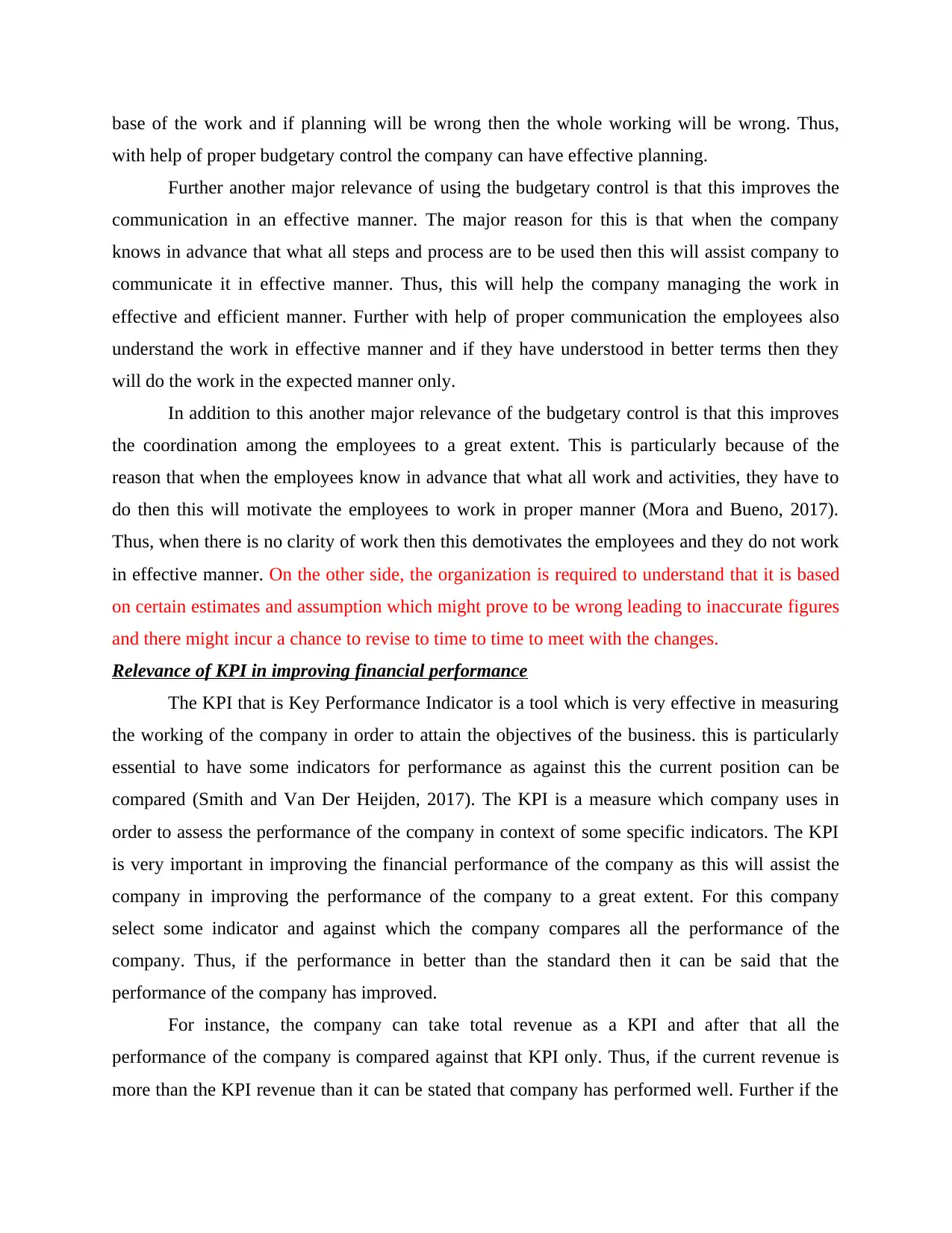
base of the work and if planning will be wrong then the whole working will be wrong. Thus,
with help of proper budgetary control the company can have effective planning.
Further another major relevance of using the budgetary control is that this improves the
communication in an effective manner. The major reason for this is that when the company
knows in advance that what all steps and process are to be used then this will assist company to
communicate it in effective manner. Thus, this will help the company managing the work in
effective and efficient manner. Further with help of proper communication the employees also
understand the work in effective manner and if they have understood in better terms then they
will do the work in the expected manner only.
In addition to this another major relevance of the budgetary control is that this improves
the coordination among the employees to a great extent. This is particularly because of the
reason that when the employees know in advance that what all work and activities, they have to
do then this will motivate the employees to work in proper manner (Mora and Bueno, 2017).
Thus, when there is no clarity of work then this demotivates the employees and they do not work
in effective manner. On the other side, the organization is required to understand that it is based
on certain estimates and assumption which might prove to be wrong leading to inaccurate figures
and there might incur a chance to revise to time to time to meet with the changes.
Relevance of KPI in improving financial performance
The KPI that is Key Performance Indicator is a tool which is very effective in measuring
the working of the company in order to attain the objectives of the business. this is particularly
essential to have some indicators for performance as against this the current position can be
compared (Smith and Van Der Heijden, 2017). The KPI is a measure which company uses in
order to assess the performance of the company in context of some specific indicators. The KPI
is very important in improving the financial performance of the company as this will assist the
company in improving the performance of the company to a great extent. For this company
select some indicator and against which the company compares all the performance of the
company. Thus, if the performance in better than the standard then it can be said that the
performance of the company has improved.
For instance, the company can take total revenue as a KPI and after that all the
performance of the company is compared against that KPI only. Thus, if the current revenue is
more than the KPI revenue than it can be stated that company has performed well. Further if the
with help of proper budgetary control the company can have effective planning.
Further another major relevance of using the budgetary control is that this improves the
communication in an effective manner. The major reason for this is that when the company
knows in advance that what all steps and process are to be used then this will assist company to
communicate it in effective manner. Thus, this will help the company managing the work in
effective and efficient manner. Further with help of proper communication the employees also
understand the work in effective manner and if they have understood in better terms then they
will do the work in the expected manner only.
In addition to this another major relevance of the budgetary control is that this improves
the coordination among the employees to a great extent. This is particularly because of the
reason that when the employees know in advance that what all work and activities, they have to
do then this will motivate the employees to work in proper manner (Mora and Bueno, 2017).
Thus, when there is no clarity of work then this demotivates the employees and they do not work
in effective manner. On the other side, the organization is required to understand that it is based
on certain estimates and assumption which might prove to be wrong leading to inaccurate figures
and there might incur a chance to revise to time to time to meet with the changes.
Relevance of KPI in improving financial performance
The KPI that is Key Performance Indicator is a tool which is very effective in measuring
the working of the company in order to attain the objectives of the business. this is particularly
essential to have some indicators for performance as against this the current position can be
compared (Smith and Van Der Heijden, 2017). The KPI is a measure which company uses in
order to assess the performance of the company in context of some specific indicators. The KPI
is very important in improving the financial performance of the company as this will assist the
company in improving the performance of the company to a great extent. For this company
select some indicator and against which the company compares all the performance of the
company. Thus, if the performance in better than the standard then it can be said that the
performance of the company has improved.
For instance, the company can take total revenue as a KPI and after that all the
performance of the company is compared against that KPI only. Thus, if the current revenue is
more than the KPI revenue than it can be stated that company has performed well. Further if the
⊘ This is a preview!⊘
Do you want full access?
Subscribe today to unlock all pages.

Trusted by 1+ million students worldwide
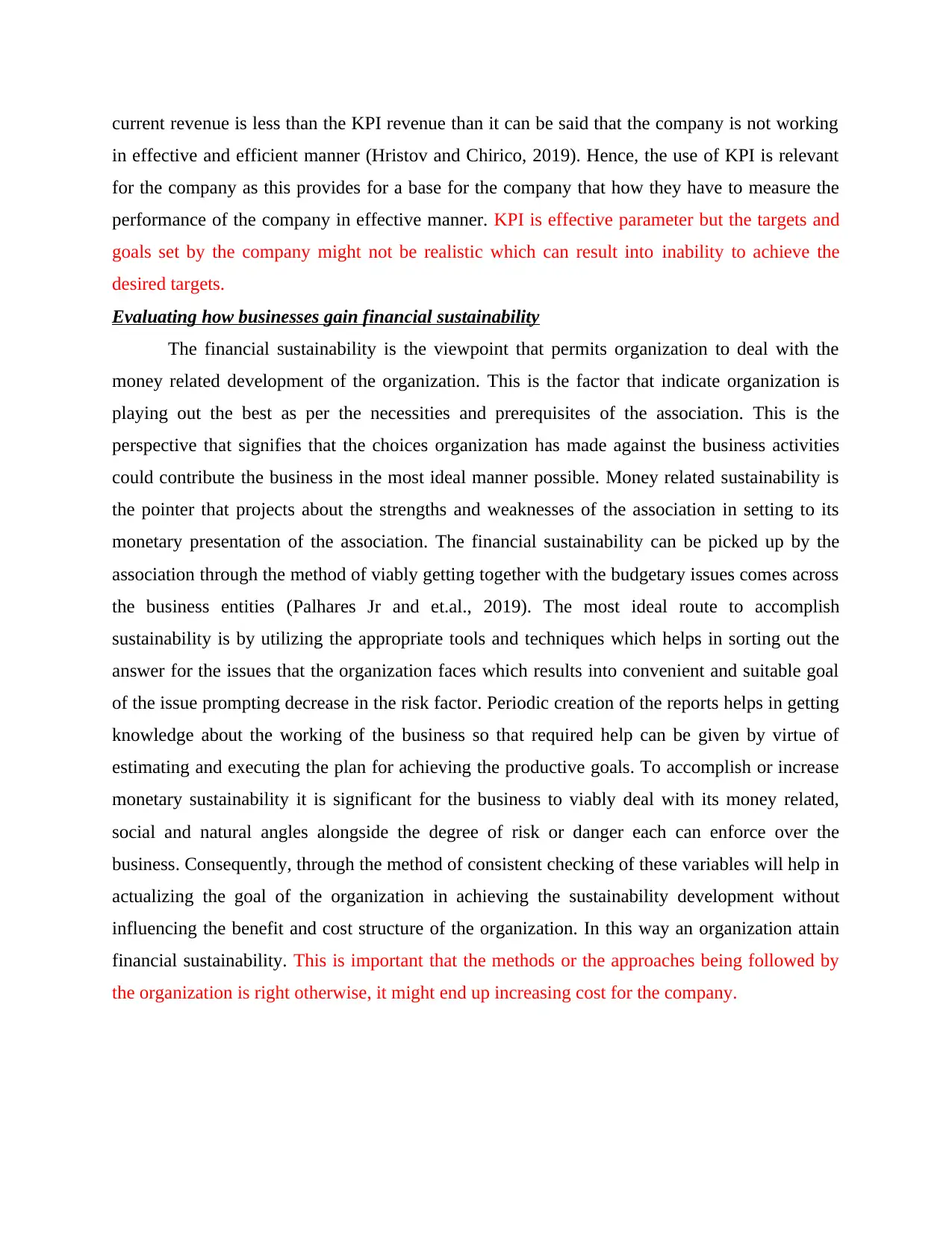
current revenue is less than the KPI revenue than it can be said that the company is not working
in effective and efficient manner (Hristov and Chirico, 2019). Hence, the use of KPI is relevant
for the company as this provides for a base for the company that how they have to measure the
performance of the company in effective manner. KPI is effective parameter but the targets and
goals set by the company might not be realistic which can result into inability to achieve the
desired targets.
Evaluating how businesses gain financial sustainability
The financial sustainability is the viewpoint that permits organization to deal with the
money related development of the organization. This is the factor that indicate organization is
playing out the best as per the necessities and prerequisites of the association. This is the
perspective that signifies that the choices organization has made against the business activities
could contribute the business in the most ideal manner possible. Money related sustainability is
the pointer that projects about the strengths and weaknesses of the association in setting to its
monetary presentation of the association. The financial sustainability can be picked up by the
association through the method of viably getting together with the budgetary issues comes across
the business entities (Palhares Jr and et.al., 2019). The most ideal route to accomplish
sustainability is by utilizing the appropriate tools and techniques which helps in sorting out the
answer for the issues that the organization faces which results into convenient and suitable goal
of the issue prompting decrease in the risk factor. Periodic creation of the reports helps in getting
knowledge about the working of the business so that required help can be given by virtue of
estimating and executing the plan for achieving the productive goals. To accomplish or increase
monetary sustainability it is significant for the business to viably deal with its money related,
social and natural angles alongside the degree of risk or danger each can enforce over the
business. Consequently, through the method of consistent checking of these variables will help in
actualizing the goal of the organization in achieving the sustainability development without
influencing the benefit and cost structure of the organization. In this way an organization attain
financial sustainability. This is important that the methods or the approaches being followed by
the organization is right otherwise, it might end up increasing cost for the company.
in effective and efficient manner (Hristov and Chirico, 2019). Hence, the use of KPI is relevant
for the company as this provides for a base for the company that how they have to measure the
performance of the company in effective manner. KPI is effective parameter but the targets and
goals set by the company might not be realistic which can result into inability to achieve the
desired targets.
Evaluating how businesses gain financial sustainability
The financial sustainability is the viewpoint that permits organization to deal with the
money related development of the organization. This is the factor that indicate organization is
playing out the best as per the necessities and prerequisites of the association. This is the
perspective that signifies that the choices organization has made against the business activities
could contribute the business in the most ideal manner possible. Money related sustainability is
the pointer that projects about the strengths and weaknesses of the association in setting to its
monetary presentation of the association. The financial sustainability can be picked up by the
association through the method of viably getting together with the budgetary issues comes across
the business entities (Palhares Jr and et.al., 2019). The most ideal route to accomplish
sustainability is by utilizing the appropriate tools and techniques which helps in sorting out the
answer for the issues that the organization faces which results into convenient and suitable goal
of the issue prompting decrease in the risk factor. Periodic creation of the reports helps in getting
knowledge about the working of the business so that required help can be given by virtue of
estimating and executing the plan for achieving the productive goals. To accomplish or increase
monetary sustainability it is significant for the business to viably deal with its money related,
social and natural angles alongside the degree of risk or danger each can enforce over the
business. Consequently, through the method of consistent checking of these variables will help in
actualizing the goal of the organization in achieving the sustainability development without
influencing the benefit and cost structure of the organization. In this way an organization attain
financial sustainability. This is important that the methods or the approaches being followed by
the organization is right otherwise, it might end up increasing cost for the company.
Paraphrase This Document
Need a fresh take? Get an instant paraphrase of this document with our AI Paraphraser

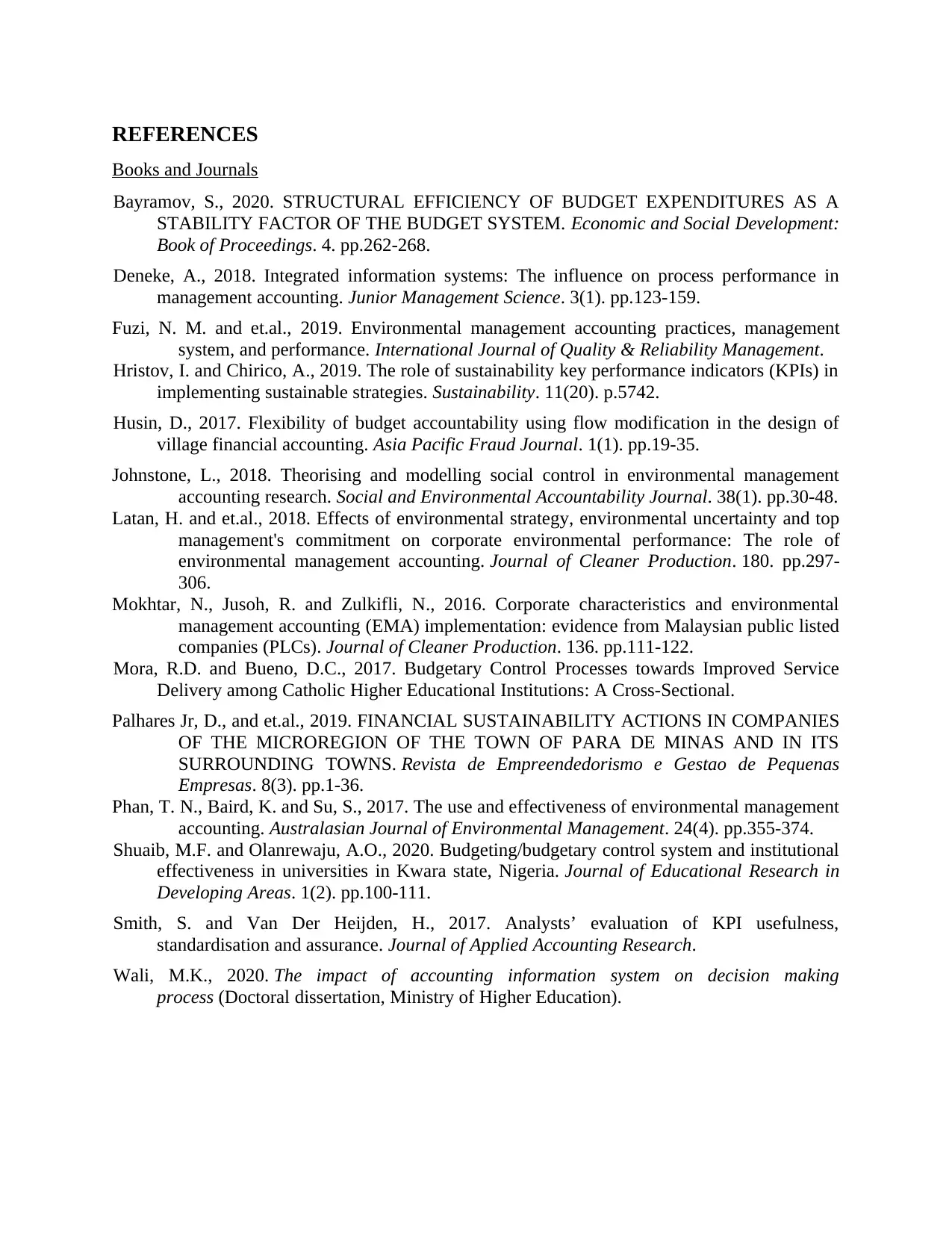
REFERENCES
Books and Journals
Bayramov, S., 2020. STRUCTURAL EFFICIENCY OF BUDGET EXPENDITURES AS A
STABILITY FACTOR OF THE BUDGET SYSTEM. Economic and Social Development:
Book of Proceedings. 4. pp.262-268.
Deneke, A., 2018. Integrated information systems: The influence on process performance in
management accounting. Junior Management Science. 3(1). pp.123-159.
Fuzi, N. M. and et.al., 2019. Environmental management accounting practices, management
system, and performance. International Journal of Quality & Reliability Management.
Hristov, I. and Chirico, A., 2019. The role of sustainability key performance indicators (KPIs) in
implementing sustainable strategies. Sustainability. 11(20). p.5742.
Husin, D., 2017. Flexibility of budget accountability using flow modification in the design of
village financial accounting. Asia Pacific Fraud Journal. 1(1). pp.19-35.
Johnstone, L., 2018. Theorising and modelling social control in environmental management
accounting research. Social and Environmental Accountability Journal. 38(1). pp.30-48.
Latan, H. and et.al., 2018. Effects of environmental strategy, environmental uncertainty and top
management's commitment on corporate environmental performance: The role of
environmental management accounting. Journal of Cleaner Production. 180. pp.297-
306.
Mokhtar, N., Jusoh, R. and Zulkifli, N., 2016. Corporate characteristics and environmental
management accounting (EMA) implementation: evidence from Malaysian public listed
companies (PLCs). Journal of Cleaner Production. 136. pp.111-122.
Mora, R.D. and Bueno, D.C., 2017. Budgetary Control Processes towards Improved Service
Delivery among Catholic Higher Educational Institutions: A Cross-Sectional.
Palhares Jr, D., and et.al., 2019. FINANCIAL SUSTAINABILITY ACTIONS IN COMPANIES
OF THE MICROREGION OF THE TOWN OF PARA DE MINAS AND IN ITS
SURROUNDING TOWNS. Revista de Empreendedorismo e Gestao de Pequenas
Empresas. 8(3). pp.1-36.
Phan, T. N., Baird, K. and Su, S., 2017. The use and effectiveness of environmental management
accounting. Australasian Journal of Environmental Management. 24(4). pp.355-374.
Shuaib, M.F. and Olanrewaju, A.O., 2020. Budgeting/budgetary control system and institutional
effectiveness in universities in Kwara state, Nigeria. Journal of Educational Research in
Developing Areas. 1(2). pp.100-111.
Smith, S. and Van Der Heijden, H., 2017. Analysts’ evaluation of KPI usefulness,
standardisation and assurance. Journal of Applied Accounting Research.
Wali, M.K., 2020. The impact of accounting information system on decision making
process (Doctoral dissertation, Ministry of Higher Education).
Books and Journals
Bayramov, S., 2020. STRUCTURAL EFFICIENCY OF BUDGET EXPENDITURES AS A
STABILITY FACTOR OF THE BUDGET SYSTEM. Economic and Social Development:
Book of Proceedings. 4. pp.262-268.
Deneke, A., 2018. Integrated information systems: The influence on process performance in
management accounting. Junior Management Science. 3(1). pp.123-159.
Fuzi, N. M. and et.al., 2019. Environmental management accounting practices, management
system, and performance. International Journal of Quality & Reliability Management.
Hristov, I. and Chirico, A., 2019. The role of sustainability key performance indicators (KPIs) in
implementing sustainable strategies. Sustainability. 11(20). p.5742.
Husin, D., 2017. Flexibility of budget accountability using flow modification in the design of
village financial accounting. Asia Pacific Fraud Journal. 1(1). pp.19-35.
Johnstone, L., 2018. Theorising and modelling social control in environmental management
accounting research. Social and Environmental Accountability Journal. 38(1). pp.30-48.
Latan, H. and et.al., 2018. Effects of environmental strategy, environmental uncertainty and top
management's commitment on corporate environmental performance: The role of
environmental management accounting. Journal of Cleaner Production. 180. pp.297-
306.
Mokhtar, N., Jusoh, R. and Zulkifli, N., 2016. Corporate characteristics and environmental
management accounting (EMA) implementation: evidence from Malaysian public listed
companies (PLCs). Journal of Cleaner Production. 136. pp.111-122.
Mora, R.D. and Bueno, D.C., 2017. Budgetary Control Processes towards Improved Service
Delivery among Catholic Higher Educational Institutions: A Cross-Sectional.
Palhares Jr, D., and et.al., 2019. FINANCIAL SUSTAINABILITY ACTIONS IN COMPANIES
OF THE MICROREGION OF THE TOWN OF PARA DE MINAS AND IN ITS
SURROUNDING TOWNS. Revista de Empreendedorismo e Gestao de Pequenas
Empresas. 8(3). pp.1-36.
Phan, T. N., Baird, K. and Su, S., 2017. The use and effectiveness of environmental management
accounting. Australasian Journal of Environmental Management. 24(4). pp.355-374.
Shuaib, M.F. and Olanrewaju, A.O., 2020. Budgeting/budgetary control system and institutional
effectiveness in universities in Kwara state, Nigeria. Journal of Educational Research in
Developing Areas. 1(2). pp.100-111.
Smith, S. and Van Der Heijden, H., 2017. Analysts’ evaluation of KPI usefulness,
standardisation and assurance. Journal of Applied Accounting Research.
Wali, M.K., 2020. The impact of accounting information system on decision making
process (Doctoral dissertation, Ministry of Higher Education).
⊘ This is a preview!⊘
Do you want full access?
Subscribe today to unlock all pages.

Trusted by 1+ million students worldwide
1 out of 12
Related Documents
Your All-in-One AI-Powered Toolkit for Academic Success.
+13062052269
info@desklib.com
Available 24*7 on WhatsApp / Email
![[object Object]](/_next/static/media/star-bottom.7253800d.svg)
Unlock your academic potential
Copyright © 2020–2025 A2Z Services. All Rights Reserved. Developed and managed by ZUCOL.





